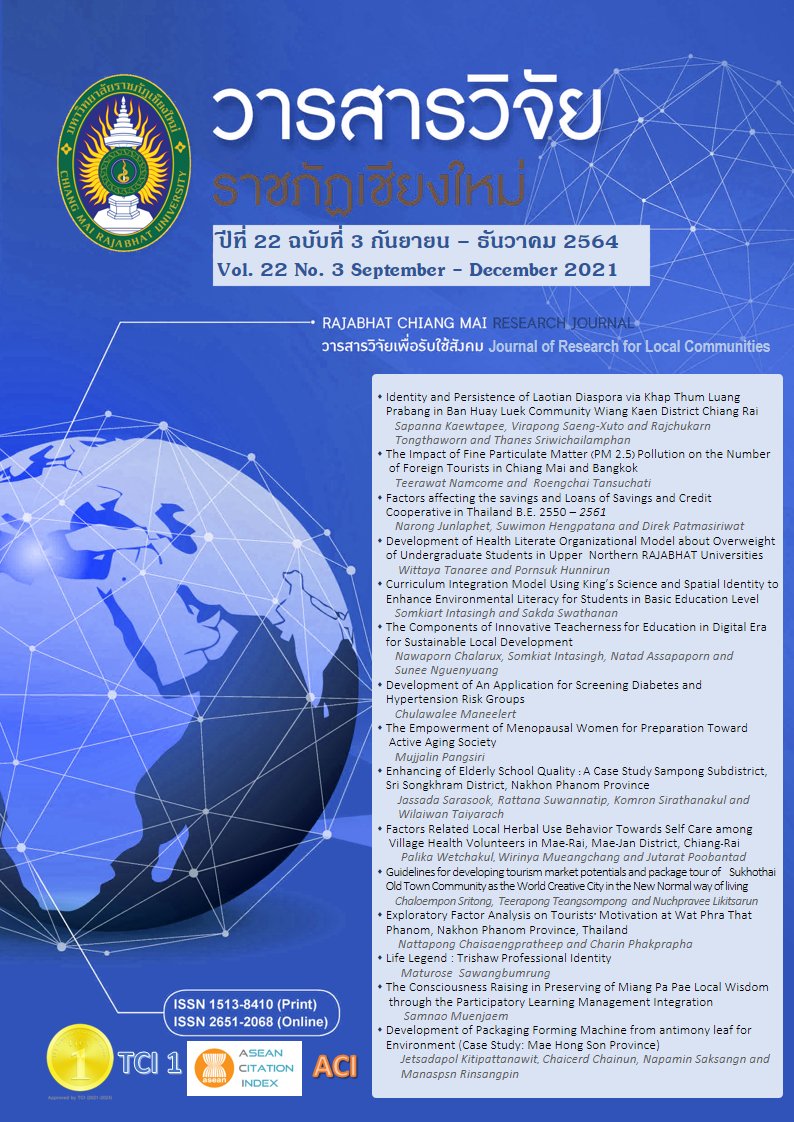The Impact of Fine Particulate Matter (PM 2.5) Pollution on the Number of Foreign Tourists in Chiang Mai and Bangkok
DOI:
https://doi.org/10.14456/rcmrj.2021.247437Keywords:
Fine particulate matter (PM 2.5) pollution, Tourist numbersAbstract
The crisis of fine particulate matter (PM 2.5) pollution has reflected an on-going increase in environmental concerns. It does not only affect human health, but also cause financial damage that leads to economy issue. This study presents the impact of PM 2.5 on the number of tourists in different periods. Using an analysis of tourists of top 20 different nationalities who visited among Chiang Mai and Bangkok, as the representative of tourist destinations with an air pollution. In this study, we used data during 2014 to 2018 and analyzed by using the Multivariate GARCH model in Diagonal BEKK terms. The study found that the fine particulate matter (PM 2.5) issue has caused the number of tourists decreased. Moreover, the finding suggested that the impacts have different consequences in different periods, especially in April and May. These results indicate that increasing of PM 2.5 index by 5% from the monthly average, the number of tourists in Chiang Mai and Bangkok will reduce by 106,060 and 659,368 people. The reduction in tourists in April and May also caused economic opportunity losses accounted for 476.27 and 4,105.13 million baht respectively. Besides, the fine particulate matter (PM 2.5) issue has affected tourists of different nationalities variously.
Downloads
References
Aiping, Z., Linsheng, Z., Yong, X., Hui, W., & Lijuan, D. (2015). Tourists’ Perception of Haze Pollution and the Potential Impacts on Travel: Reshaping the Features of Tourism Seasonality in Beijing, China. journal Sustainability 2015, 7(3), 2397-2414. DOI: https://doi.org/10.3390/su7032397
Akkarapol, A., (2011). Impacts of Crisis Events on International Tourism Demand in Thailand. Applied Economics Journal, 18(2), 45-64. https://so01.tci-thaijo.org/index.php/AEJ/article/view/10403 (In Thai)
Anaman, K.A., & Looi, C.N. (2000). Econmic Impact of Haze-Related and Pollution on The Tourism Industry in Brunei Darussalam. Economic : Analysis & Policy, 30(2), 133-143. DOI: https://doi.org/10.1016/S0313-5926(00)50016-2
Cheung, C., & Law, R. (2001). The Impact of Air Quality on Tourism: The Case of Hongkong. Pacific Tourism Review, 5(1/2), 69-74. https://ira.lib.polyu.edu.hk/handle/10397/8803
Chiang-Ming, C., Yo-Long, L., & Chien-Lung, H. (2017). Does air pollution drive away tourists? A case study of the Sun Moon Lake National Scenic Area, Taiwan. Transportation Research Part D Transport and Environment, 53, 398-402. DOI: https://doi.org/10.1016/j.trd.2017.04.028
Daxin, D., Xiaowei, X., & Yatfung, W. (2019). Estimating the Impact of Air Pollution on Inbound Tourism in China : An Analysis Based on Regression Discontinuity Design. Sustainability MDPI Open Access Journal, 11(6), 1682. DOI: https://doi.org/10.3390/su11061682
Daxin, D., Xiaowei, X., Hong, Y., & Yanfang , Z. (2019). The Impact of Air Pollution on Domestic Tourism in China: A Spatial Econometric Analysis. Sustainability MDPI Open Access Journal, 11(15), 1-16. https://ideas.repec.org/a/gam/jsusta/v11y2019i15p4148-d253636.html
Department of Tourism. (2019). Tourist Statistics. Retrieved from http://www.tourism.go.th (In Thai)
Goeldner, C. R.andRitchies, B. J. (2006). Tourism: Principles, practices and philosophies. New Jersey: John Wiley and Sons.
Greenpeace Thailand. (2018). Air pollution problem . Retrieved from https://www.greenpeace.org/archive-thailand/campaigns/Urban-Revolution/Air-Pollution (In Thai)
Greenpeace Thailand. (2018). PM2.5 toxic dust, why would anyone say it bad?. Retrieved from https://www.greenpeace.org/thailand/story/2162/pm25-invisible-villians (In Thai)
Kasikorn Research (2019). The result of dust particles in Bangkok Expected to affect the economy 2,600 million. Retrieved from https://www.bangkokbiznews.com/news/detail/824223 (In Thai)
McAleer, M. (2019). What They Did Not Tell You about Algebraic (Non-) Existence, Mathematical (IR-)Regularity and (Non-) Asymptotic Properties of the Full BEKK Dynamic Conditional Covariance Model, Journal of Risk and Financial Management, 12(2), 66. DOI: https://doi.org/10.3390/jrfm12020066
National Statistical Office, (2019). Tourist and sports statistics. Retrieved from
http://statbbi.nso.go.th/staticreport/page/sector/th/17.aspx (In Thai)
Pakpong, P. (2016). The present state of urban air pollution problems in Thailand’s large cities: cases of Bangkok, Chiang Mai, and Rayong. Journal of Environmental Management, 12(1), 114-133. https://so02.tci-thaijo.org/index.php/JEM/article/view/47808 (In Thai)
Pollution Control Department. (2013). Air Pollution and Noise: Situation and Management 2012 In Thai. Bangkok: Ministry of Natural Resources and Environment. (In Thai)
Pollution Control Department. (2018). Report of the situation of dust particles as small as 2.5 microns in 2019. Retrieved from http://www.pcd.go.th/info_serv/air_pm25.html (In Thai)
PPTV News. (2019). Smash the record for PM2.5, the highest PM2.5 value in the world. Retrieved from https://www.pptvhd36.com/news (In Thai)
Roengchai, T. (2010). Econometrics. Chiang Mai: Chotana Print Company Limited. (In Thai)
Susanne, B., Xin, j., Chen, Z., & Jun, G. (2017). Urban air pollution in China: destination image and risk perceptions. Journal of Sustainable Tourism Volume 25, 25(1), 130-147. DOI: https://doi.org/10.1080/09669582.2016.1177067
Sun, X. (2016). Air Pollution Analysis to The Better Management of The Tourism Industry In China. (Degree in Tourism, Universital de les Illes Balears.)
Downloads
Published
How to Cite
Issue
Section
License
1. Articles, information, content, images, etc published in the “Community and Social Development Journal” are copyrighted by the Community and Social Development Journal, Chiang Mai Rajabhat University. In order to properly distribute the articles through print and electronic media, the authors still hold the copyright for the published articles under the Creative Commons Attribution (CC BY) license, which allows the re-distribution of the articles in other sources. References must be made to the articles in the journal. The authors are responsible for requesting permission to reproduce copyrighted content from other sources.
2. The content of the articles appearing in the journal is the direct responsibility of the article authors. The editorial board of the journal does not necessarily agree with or share any responsibility.














